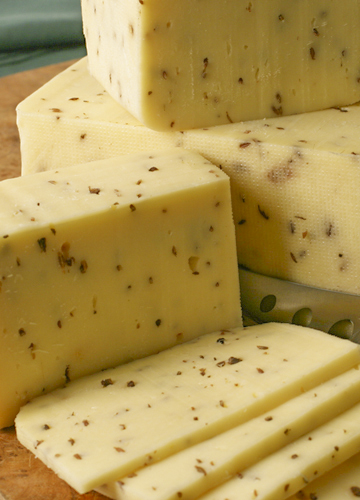Nokkelost Info
Nokkelost a Spicy Norwegian Treat
In this recipe we venture to the far north of Europe into Norway for a cheese that has always been considered their year end Holiday Cheese. The appreciation for this cheese has especially extended to the places Norwegians have emigrated to over the past many years.
The Nokkelost cheese has a medium to medium firm body, a supple texture and is laced with bits of caraway seeds and broken cloves. It also retains a slight sweetness in the finish.
In my own hybrid style I had to add my own twist to things and since Cardamom has been such a wonderful spice used by the Norwegians and my remembrance of the spice used in milk drinks (Lassi, Teas etc.). I added a Cardamom infusion to the cheese milk as well.
It just smells so Good I just had to do it.
Nokkelost in America
At one time Nokkelost style cheese was made in America for the large Norwegian communities. However these traditional cheeses have either disappeared or evolved into non recognizable versions and the imports have become harder to find.
I have a good friend in Colorado who grew up in one of these American/Norwegian families in the midwest and remembers this cheese from earlier years as a special treat. He has been after me for years to make one for him (actually to teach him cheese making in general). So, this years American Cheese Society Conference in Denver gave me the opportunity to spend some time with him and between the research of locally produced Colorado beers and our catching up, we put our minds and hands into making what he remembers as Nokkelost (I had been gathering notes on the making of this for a few years by then).
What we put together may not be true to style but with my technical input and my friends memories of this cheese from the past this is what I am offering here 'in the style of' Nokkelost. Yes, perhaps even a Hybrid but that's the beauty of making your own cheese, get a pretty good game plan and run with it. Cheese making should be fun and reember, each cheese is unique.
A Breif History of Nokkelost
The term "Nokkel" in Norwegian translates into "crossed keys," which is part of the symbol used by the Dutch city of Leiden to denote products produced within, and adjacent to, their city. So to see the traditional cheese, you would notice the crossed-keys emblem; it symbolizes the cheese's association with the Leiden heritage.
Originally it was produced in Holland by the city of Leiden (or Leyden) where the crossed keys represented the emblem found at its city gates.
The cheese was made as a semi-hard cheese, its name translates into “key cheese” (Ost = Norwegian for cheese)
The cheese has been made since the 17th century and In the late 1860s, Leyden cheese was important enough to be accepted as payment when trade was done between the two countries, and when the trade stopped, the Norwegians began making their own version of this cheese.
What is Nokkelost
The cheese is of a semi firm texture and from my research the original cheese was only spiced with Caraway. In Norway it has been traditionally served as thin slices cut with a cheese plane and served on the dark bread, famous in the north.
Nokkelost is good cubed in salads or shredded and baked in scalloped potatoes, it melts well and can be a unique main ingredient for grilled-cheese sandwiches. It partners well with beer and wine, especially when served with dark breads, such as pumpernickel.
The clove addition seems to have been added when they began making the cheese in Norway but it must not be strong enough to mask the cheese and its caraway character.
As the Norwegian communities began to develop in America, they felt a need for their own cheese and at one point Kraft was making a cheese in America that they originally called "Caraway Cheese" but later changed to "Kuminost Spiced Cheese". The Caraway addition is confusing because some references say that it is cumin that is added instead of caraway.
This is confusing but my research has shown me that Caraway herb seeds are also called Persian Cumin the confusion here is that in India, Jeera is the name for Cumin whereas Shahi Jeera is the name for Caraway. They both look somewhat similar but they are not.
All very confusing but I am sticking with Caraway as the addition because Cumin just seems wrong with its warm flavors and I can easily see its flavors masking the character of the cheese. The Caraway with its brighter flavor seems to add that additional zip to add to the character of the cheese.
The Clove addition needs to also be subtle with less used than the Caraway for a balanced cheese. Sometimes less is more.
Now for my addition of Cardamom. Cardamom (Kardemumma) is not traditional in this cheese but huge on many Norwegian tables, Especially in breads.
Vikings came upon cardamom about one thousand years ago, in Constantinople, and introduced it into Scandinavia, where it remains popular. Norway is still today one of the biggest consumers of this spice.
But why did I bring it into this cheese?? Many years ago a friend had made a Cardamom ice cream for me several times and I never forgot how well the brightness of this spice went with the dairy aspect. Also the 'Lassi' accompanying Indian meals is also in my taste memory and I thought this would be my own little addition to this historical cheese from Norway(I cant believe no one else has done this yet and I am sure they have).
When I mentioned the infusion of Cardamom into the milk my friend agreed how right it seemed. As already mentioned Cardamom is used in many breads in Norway.

































